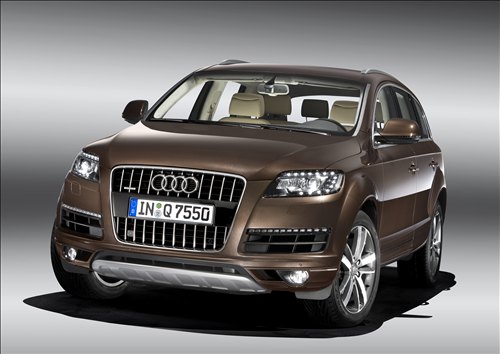 Audi Q7 Cars
Audi Q7 Cars  Audi Q7 Car
Audi Q7 Car Audi Q7 Cars Review
Audi Q7 Cars Review The Audi Q7 is a big car in many respects. As well as its physical size, it also has a big heart, which is about to get even bigger, but more of that later.
For now, the largest engine available is the 4.2 V8, which comes in both petrol (FSI) and diesel (TDI) versions. The TDI is a recent addition to the existing 3.0 TDI, 3.6 FSI V6 units and the 4.2 FSI.
The 4.2 TDI boasts twin turbochargers - one for each bank of cylinders- and two intercooler's, all helping to achieve a power output of 326PS at 3,750rpm and a massive amount of torque - 760Nm between 1,800- and 2,500rpm. It is this amazing pulling power that makes the Q7 such an exhilarating drive and gives the car the status of being the most powerful, diesel-engined SUV, that money can buy, according to Audi.
 hat will remain the case until the mighty but mad, 6.0-litre, V12 unit comes aboard. Developed from the V12 unit used in the Audi R10 TDI, which was the first diesel-powered car to win Le Mans. With these credentials, you would expect it to be something special and the crazy figures are testament to this - 500PS at 4,000rpm and an incomprehensible, 1,000Nm from 1,750- to 3,000rpm! The 0-62mph time for the V12 is just 5.5seconds and the top speed is limited to 155mph.
hat will remain the case until the mighty but mad, 6.0-litre, V12 unit comes aboard. Developed from the V12 unit used in the Audi R10 TDI, which was the first diesel-powered car to win Le Mans. With these credentials, you would expect it to be something special and the crazy figures are testament to this - 500PS at 4,000rpm and an incomprehensible, 1,000Nm from 1,750- to 3,000rpm! The 0-62mph time for the V12 is just 5.5seconds and the top speed is limited to 155mph. But that’s in the near future. For now the 4.2 TDI is top of the Q7 tree, with a sprint time of 6.4 seconds, which is faster than the Honda Civic Type R and the Ford Focus ST-500 and ridiculously quick for a car of this size, and the top speed is 146mph.
Where possible (and legal), this acceleration is best experienced on a motorway, where you can feel the torque taking hold. Around town, on the other hand, the Q7 has a tendency to feel lumpy and cumbersome and, at over 5 metres long and almost 2 metres wide, it is difficult to find a parking space that will accommodate its bulk. That said, when a space is found, the Q7 is reasonably easy to manoeuvrable.
All Q7s have adaptive air suspension as standard. This works in conjunction with an electronically-controlled, damping system. Under normal driving conditions, there are three different settings, selected via the Multi Media Interface (MMI). The ‘comfort’ setting is great for motorway driving but is far too soft for minor roads.
Audi Q7 Car Audi Q7 Car
Audi Q7 Car Audi Q7 Car
Audi Q7 Car Audi Q7 Car
Audi Q7 Car
No comments:
Post a Comment